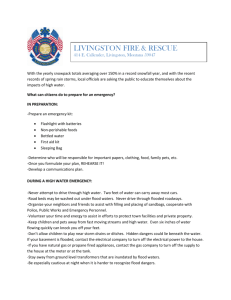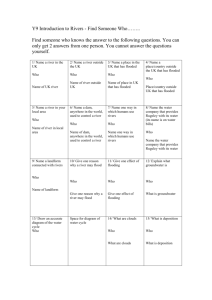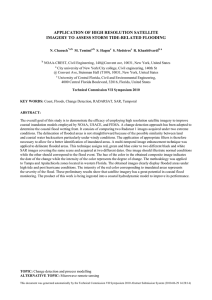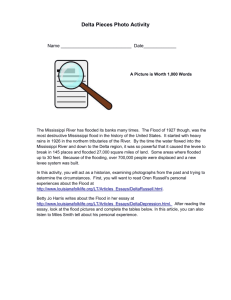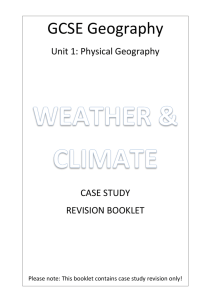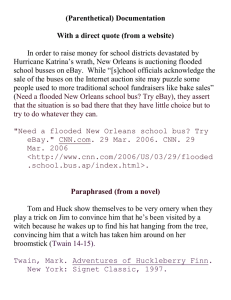CLASSIFICATION SYSTEM OF GIS-OBJECTS USING MULTI-SENSORIAL IMAGERY FOR NEAR-REALTIME DISASTER MANAGEMENT
advertisement
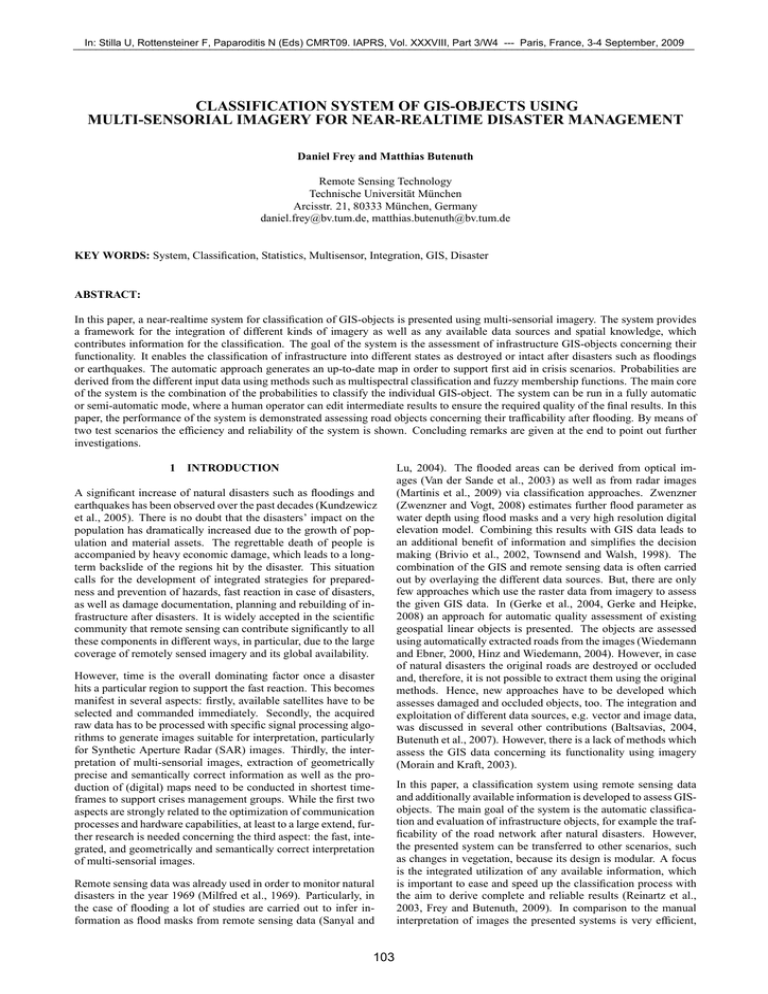
In: Stilla U, Rottensteiner F, Paparoditis N (Eds) CMRT09. IAPRS, Vol. XXXVIII, Part 3/W4 --- Paris, France, 3-4 September, 2009
¯¯¯¯¯¯¯¯¯¯¯¯¯¯¯¯¯¯¯¯¯¯¯¯¯¯¯¯¯¯¯¯¯¯¯¯¯¯¯¯¯¯¯¯¯¯¯¯¯¯¯¯¯¯¯¯¯¯¯¯¯¯¯¯¯¯¯¯¯¯¯¯¯¯¯¯¯¯¯¯¯¯¯¯¯¯¯¯¯¯¯¯¯¯¯¯¯¯¯¯¯¯¯¯¯¯¯¯¯
CLASSIFICATION SYSTEM OF GIS-OBJECTS USING
MULTI-SENSORIAL IMAGERY FOR NEAR-REALTIME DISASTER MANAGEMENT
Daniel Frey and Matthias Butenuth
Remote Sensing Technology
Technische Universität München
Arcisstr. 21, 80333 München, Germany
daniel.frey@bv.tum.de, matthias.butenuth@bv.tum.de
KEY WORDS: System, Classification, Statistics, Multisensor, Integration, GIS, Disaster
ABSTRACT:
In this paper, a near-realtime system for classification of GIS-objects is presented using multi-sensorial imagery. The system provides
a framework for the integration of different kinds of imagery as well as any available data sources and spatial knowledge, which
contributes information for the classification. The goal of the system is the assessment of infrastructure GIS-objects concerning their
functionality. It enables the classification of infrastructure into different states as destroyed or intact after disasters such as floodings
or earthquakes. The automatic approach generates an up-to-date map in order to support first aid in crisis scenarios. Probabilities are
derived from the different input data using methods such as multispectral classification and fuzzy membership functions. The main core
of the system is the combination of the probabilities to classify the individual GIS-object. The system can be run in a fully automatic
or semi-automatic mode, where a human operator can edit intermediate results to ensure the required quality of the final results. In this
paper, the performance of the system is demonstrated assessing road objects concerning their trafficability after flooding. By means of
two test scenarios the efficiency and reliability of the system is shown. Concluding remarks are given at the end to point out further
investigations.
1
INTRODUCTION
A significant increase of natural disasters such as floodings and
earthquakes has been observed over the past decades (Kundzewicz
et al., 2005). There is no doubt that the disasters’ impact on the
population has dramatically increased due to the growth of population and material assets. The regrettable death of people is
accompanied by heavy economic damage, which leads to a longterm backslide of the regions hit by the disaster. This situation
calls for the development of integrated strategies for preparedness and prevention of hazards, fast reaction in case of disasters,
as well as damage documentation, planning and rebuilding of infrastructure after disasters. It is widely accepted in the scientific
community that remote sensing can contribute significantly to all
these components in different ways, in particular, due to the large
coverage of remotely sensed imagery and its global availability.
However, time is the overall dominating factor once a disaster
hits a particular region to support the fast reaction. This becomes
manifest in several aspects: firstly, available satellites have to be
selected and commanded immediately. Secondly, the acquired
raw data has to be processed with specific signal processing algorithms to generate images suitable for interpretation, particularly
for Synthetic Aperture Radar (SAR) images. Thirdly, the interpretation of multi-sensorial images, extraction of geometrically
precise and semantically correct information as well as the production of (digital) maps need to be conducted in shortest timeframes to support crises management groups. While the first two
aspects are strongly related to the optimization of communication
processes and hardware capabilities, at least to a large extend, further research is needed concerning the third aspect: the fast, integrated, and geometrically and semantically correct interpretation
of multi-sensorial images.
Remote sensing data was already used in order to monitor natural
disasters in the year 1969 (Milfred et al., 1969). Particularly, in
the case of flooding a lot of studies are carried out to infer information as flood masks from remote sensing data (Sanyal and
103
Lu, 2004). The flooded areas can be derived from optical images (Van der Sande et al., 2003) as well as from radar images
(Martinis et al., 2009) via classification approaches. Zwenzner
(Zwenzner and Vogt, 2008) estimates further flood parameter as
water depth using flood masks and a very high resolution digital
elevation model. Combining this results with GIS data leads to
an additional benefit of information and simplifies the decision
making (Brivio et al., 2002, Townsend and Walsh, 1998). The
combination of the GIS and remote sensing data is often carried
out by overlaying the different data sources. But, there are only
few approaches which use the raster data from imagery to assess
the given GIS data. In (Gerke et al., 2004, Gerke and Heipke,
2008) an approach for automatic quality assessment of existing
geospatial linear objects is presented. The objects are assessed
using automatically extracted roads from the images (Wiedemann
and Ebner, 2000, Hinz and Wiedemann, 2004). However, in case
of natural disasters the original roads are destroyed or occluded
and, therefore, it is not possible to extract them using the original
methods. Hence, new approaches have to be developed which
assesses damaged and occluded objects, too. The integration and
exploitation of different data sources, e.g. vector and image data,
was discussed in several other contributions (Baltsavias, 2004,
Butenuth et al., 2007). However, there is a lack of methods which
assess the GIS data concerning its functionality using imagery
(Morain and Kraft, 2003).
In this paper, a classification system using remote sensing data
and additionally available information is developed to assess GISobjects. The main goal of the system is the automatic classification and evaluation of infrastructure objects, for example the trafficability of the road network after natural disasters. However,
the presented system can be transferred to other scenarios, such
as changes in vegetation, because its design is modular. A focus
is the integrated utilization of any available information, which
is important to ease and speed up the classification process with
the aim to derive complete and reliable results (Reinartz et al.,
2003, Frey and Butenuth, 2009). In comparison to the manual
interpretation of images the presented systems is very efficient,
CMRT09: Object Extraction for 3D City Models, Road Databases and Traffic Monitoring - Concepts, Algorithms, and Evaluation
¯¯¯¯¯¯¯¯¯¯¯¯¯¯¯¯¯¯¯¯¯¯¯¯¯¯¯¯¯¯¯¯¯¯¯¯¯¯¯¯¯¯¯¯¯¯¯¯¯¯¯¯¯¯¯¯¯¯¯¯¯¯¯¯¯¯¯¯¯¯¯¯¯¯¯¯¯¯¯¯¯¯¯¯¯¯¯¯¯¯¯¯¯¯¯¯¯¯¯¯¯¯¯¯¯¯¯¯¯
which is essential in crisis scenarios. Depending on the type and
complexity of the input data, the system can be run in a fully
automatic or semi-automatic mode, where a human operator can
edit intermediate results to ensure the required quality of the final
results.
Section 2 describes the generic near-realtime classification system with the objective to classify and evaluate objects using remote sensing and other available data. In Section 3 the system is
applied to road objects in case of natural disasters. Two test scenarios of flooded areas are used to verify the system. By means
of manually generated reference data, the applicability and efficiency of the system is evaluated in Section 4. Finally, further
investigations in future work are pointed out.
2
CLASSIFICATION SYSTEM
The goal of the developed classification system is the assessment
of GIS-objects using up-to-date remote sensing data. The system
is designed in a general and modular way to provide the opportunity to label GIS-objects into different states. Typical states describe the functionality of infrastructure objects as roads or buildings. The generic system embeds different kinds of image data:
multi-sensor as well as multi-temporal data. Additionally, any
kinds of available data sources and spatial knowledge, which contributes information for the assessment, can be embedded. Typical examples are digital elevation models (DEM) and further GIS
information, e.g. land cover or waterways. The minimum requirement of the system are the objects to be assessed and one
up-to-date image which provides the information for the assessment.
The fusion of multi-sensor images is an important issue, because
the corregistration between optical and radar images is still a current research topic (Pohl and Van Genderen, 1998). Methods
such as mutual information can be applied for the system (Inglada
and Giros, 2004). The system has to deal with multi-temporal
images having the possibility to derive important information on
time. This leads to an even more complex corregistration process. Change detection algorithms can provide information about
the variation of assessed objects. In this article the temporal factor is neglected, but will be an essential part in future research.
The main core of the system represents the classification. The
goal is to classify each object into a different state Si . For each
object probabilities are derived belonging to a certain state. The
methods estimating the probabilities depends on the data: typical examples are multispectral classification or fuzzy membership functions (Figure 2).
GISObject
data 1
method 1
pd1S1, pd1S2,
... , pd S
data 2
method 2
pd2S1, pd2S2,
... , pd S
...
...
data n
method n
1 3
2 3
...
pdnS1, pdnS2,
... , pd S
n 3
Figure 2: Derivation of probabilities from data using various
methods
GISobject
Beside the derivation of the individual probabilities from each
data source the combination plays a decisive role:
Optical
Imagery 1
Time
Point t1
SAR
Imagery 1
DEM
pS1 = pd1 ,S1 ⊗ pd2 ,S1 ⊗ · · · ⊗ pdn ,S1
pS2 = pd1 ,S2 ⊗ pd2 ,S2 ⊗ · · · ⊗ pdn ,S2
..
.
pSi = pd1 ,Si ⊗ pd2 ,Si ⊗ · · · ⊗ pdn ,Si .
Classification
System
(1)
GIS
The variable pdn ,Si denotes the probability that the state Si occurs given data dn . The indices i and n describe the number of
available states and data, respectively. The result pSi shows the
probability that a GIS-object belongs to the state Si . For each
type of data weights wn can be introduced in order to cope with
the different influence of information content. Hence, Equation 1
for one state i leads to:
Optical
Imagery 2
Time
Point t2
SAR
Imagery 2
......
Classification
System
pSi = w1 · pd1 ,Si ⊗ · · · ⊗ wn · pdn ,Si .
up-to-date
map
(2)
Finally, the object is assigned to the state Si with the largest probability pSi . A basic characteristic of the whole system is the
combination at the probability level in order to remain flexible
concerning the available data.
Figure 1: Classification system
The classification system depicted in Figure 1 can be subdivided
into different components. Starting point are the GIS-objects to
be assessed. Secondly, the input data as imagery or digital elevation models which contribute the information for the assessment.
In the following this information is called data. Thirdly, the classification system by itself and, finally, a resulting up-to-date map.
104
3
MODEL FOR ROAD OBJECTS
After describing the generic system, a model is shown which assesses linear objects as roads after flooding. However, this model
is transferable to other linear objects like railways and further
In: Stilla U, Rottensteiner F, Paparoditis N (Eds) CMRT09. IAPRS, Vol. XXXVIII, Part 3/W4 --- Paris, France, 3-4 September, 2009
¯¯¯¯¯¯¯¯¯¯¯¯¯¯¯¯¯¯¯¯¯¯¯¯¯¯¯¯¯¯¯¯¯¯¯¯¯¯¯¯¯¯¯¯¯¯¯¯¯¯¯¯¯¯¯¯¯¯¯¯¯¯¯¯¯¯¯¯¯¯¯¯¯¯¯¯¯¯¯¯¯¯¯¯¯¯¯¯¯¯¯¯¯¯¯¯¯¯¯¯¯¯¯¯¯¯¯¯¯
natural disasters such as avalanches, landslides or earthquakes.
In case of natural disasters the GIS-object can be divided into the
state intact/usable or not intact/destroyed. Furthermore, a state
between these extrema is possible. Hence, a third state possibly
not intact/destroyed is introduced, if the automatic approach can
not provide a reliable decision. In order to assess roads after a
flood disaster following states can be used:
a1 = l l − b 1
a2 = l h + b 2 ,
(3)
in which ll is the lowest and lh is the highest water level in the
scene. In order to involve variations due to flows and barriers
additional buffers b1 , b2 are added.
• trafficable
µf(a)
µt(a)
1
• flooded
• possibly flooded
For every available data source the probability for each state has
to be derived. The methods which are employed to the different
data are shown in the following section.
3.1
0.5
Methods
A multispectral classification is accomplished in order to derive
different classes from the input imagery. The goal is to assess
each linear object individually without taking adjacent linear objects into account, because such kind of topological knowledge
about the connectivity of a road network is no more valid in case
of road networks hit by a natural disaster. Every linear object is a
polyline, which consists of several line segments. A line segment
is a straight line, which can be defined with two points. Every line
segment is assigned to a class using an segment-based multispectral classification. To this end, a buffer is defined around each line
to investigate the radiometric image information. In many cases
additional information as the width of the line object can be used
in order to generate the size of the buffer region.
For the multispectral classification various classes have to be defined depending on the underlying imagery in order to classify the
road segments into the three states trafficable, flooded and possibly flooded. In case of optical imagery the classes road, water,
forest and clouds are convenient, because the class road corresponds to the state trafficable, the class water to flooded and the
classes forest and clouds describe occlusions and therefore belong to the state possibly flooded. If radar images are available
the class clouds can be neglected. Beside the assignment to a
class each individual line segment consists of a probability belonging to a class ωi , which is derived from the k-sigma error
ellipsoid. The probability can be formulated as pωi (~g ), whereas
~g defines the gray values. The length of the vector is equivalent
to the number of channels.
Beside the imagery additional information such as digital elevation models or GIS data can be integrated in the system. The
methods to derive probabilities depend on the data. One method
are membership functions of fuzzy sets (Zadeh, 1965). Membership functions do not describe the likelihood of some event,
but they only characterize a degree of truth in vaguely defined
sets. Since it is often difficult to derive sound probabilities from
GIS data, membership functions provide an opportunity to infer
confidence values. To emphasize the distinction the membership
function is labeled as µ instead of p.
The membership functions µt (a), µf (a) are introduced if a digital elevation model is given. The function µt (a) denote the belonging to the state trafficable t depending on the altitude a. Similarly µf (a) represents the state flooded f . Both functions are
depicted in Figure 3. There are two thresholds a1 and a2 which
determine the height of very likely flooded or trafficable areas, respectively. The current water level lies between these thresholds,
which can be calculated by
105
0
a1
Water Level
a2
Altitude
Figure 3: Membership functions for flooded roads and trafficable
roads derived from DEM
3.2
Combination of Probabilities
The core of the classification system is to combine probabilities
resulting from a multispectral classification with the degree of
truth of membership functions. In this section, an example is
shown which combines the derived probabilities from optical images with membership functions inferred from a digital elevation
model. By means of multispectral classification for each class
(water w, road r, forest o, cloud c) the corresponding probability pωi for i = {w, r, o, c} can be derived. On the other side,
the membership function provide the degree of truth µt (a) and
µf (a). Utilizing the knowledge that roads higher than a2 are definitely trafficable and roads lower than a1 are very likely flooded
a case differentiation is carried out:
a ≤ a1
µf (a) = 1
µf (~g , a) = µf (a) · pωw (~g ) a1 < a < a2
µ (a) = 0
a ≥ a2
f
(4)
a ≤ a1
µt (a) = 0
µt (~g , a) = µt (a) · pωr (~g ) a1 < a < a2
µ (a) = 1
a ≥ a2 .
t
(5)
Variable a denotes the height of a road object. The road is assigned to the state flooded SF if the degree of truth µf (~g , a) exceeds an threshold t1 , which can be pre-estimated via the standard deviation of the likelihood function resulting from the training data for water. The road is assigned to the state possibly
flooded SP F , if µf (~g , a) is less than t1 . The probability µt (~g , a)
is treated in an analogous manner. The road is assigned to the
state trafficable ST if µt (~g , a) exceeds a pre-determined threshold t2 . Otherwise, the road is again assigned to the state possibly
flooded SP F . The road segments which are classified as forest
ωo or clouds ωc are assigned to the states in the following way:
a < a1
a1 < a < a 2
a > a2
⇒ flooded SF
⇒ possibly flooded SP F
⇒ trafficable ST
(6)
CMRT09: Object Extraction for 3D City Models, Road Databases and Traffic Monitoring - Concepts, Algorithms, and Evaluation
¯¯¯¯¯¯¯¯¯¯¯¯¯¯¯¯¯¯¯¯¯¯¯¯¯¯¯¯¯¯¯¯¯¯¯¯¯¯¯¯¯¯¯¯¯¯¯¯¯¯¯¯¯¯¯¯¯¯¯¯¯¯¯¯¯¯¯¯¯¯¯¯¯¯¯¯¯¯¯¯¯¯¯¯¯¯¯¯¯¯¯¯¯¯¯¯¯¯¯¯¯¯¯¯¯¯¯¯¯
In Figure 4 a schematic overview of the used classification system is depicted. A multispectral classification is carried out to
assign the road objects to the different classes. The results of the
multispectral classification combined with the membership function leads to the assignment of the road objects to the different
states.
Multispectral Classification
water
flooded
clouds
forest
possibly
flooded
later than the studied TerraSAR-X scene was used to infer the exact ground truth. To draw conclusions from the following results,
it is important to consider the kind of used reference data.
The result of the Elbe scene is visualized in Figure 5. The red
lines refer to flooded roads, green lines to trafficable roads and
the yellow lines point out, that no decision is possible by the automatic system. In Figure 6 a detail of the original IKONOS image
and the assessed roads is shown.
roads
trafficable
Figure 4: Schematic overview of the classification system
4
RESULTS AND EVALUATION
The presented system has been exemplarily tested with two scenarios representing flood disasters. In both cases roads are assessed concerning their trafficability. The first scenario is the Elbe
flood in the year 2002 near Dessau, Germany. Three different
data sources are used for the assessment: Firstly, an IKONOSImage with four channels (red, green, blue and infrared), cf. Figure 5. The ground-sampling distance of the panchromatic channel is 1 meter and the color-channels is 4 meter. As second
source a digital elevation model with a resolution of 10 meters
is used. Finally, the objects to be assessed are taken form the
ATKIS (German Official Topographic Cartographic Information
System) database. The test scene covers an area of 33 km2 , which
contains 5484 line segments. In the following investigations only
the road objects are studied.
The second study area is located in Gloucesterhire Region in
Southeast England. In July 2007 the record flood level at Tewkesbury was measured. During the flooding a TerraSAR-X scene in
StripMap mode with a spatial resolution of 3 meter was acquired.
The polarization is HH, which is more efficient than HV or VV
to distinguish flooded areas (Henry et al., 2003). The test scene
covers an area of of 9,5 km2 . Additionally, linear membership
functions from the original rivers are derived and an automatically extracted flood mask is used. As GIS-objects 522 roads
from OpenStreetMap are assessed.
The test scenarios are very appropriate to test the classification
system due to their diverse global context and the different kinds
of roads. The roads vary from paths to highways. Both test scenarios are evaluated using manually derived reference data. The
availability of reference data describing the real status of roads
during the flooding is very difficult caused by the fast changes of
the water level and the accessibility of the roads. One possibility is to derive the reference data from the image itself, which is
done for the Elbe scenario. This kind of reference data does not
describe the ground truth, but the information which is possible
to get from the studied image. In the case of the Gloucesterhire
scenario high resolution airborne image with a resolution of 20
cm are available. This imagery which was acquired half a day
106
Figure 5: Automatic assessment of roads using the classification
system: flooded roads (red), trafficable roads (green) and possibly
flooded roads (yellow)
Figure 6: Detail of original and assessed IKONOS scene
Comparing the result with the manually generated reference leads
to the numerical results shown in Table 1. ”Correct assignment”
means that the manually generated classification is identical with
the automatic approach. In the case of ”Manuel control necessary” the automatic approach leads to the state possibly flooded
whereas the manual classification assigns the line segments to
flooded or trafficable. The other way around denotes the expression ”Possibly correct assignment”. ”Wrong assignment”’ means
that one approach classifies the line segment to flooded and the
other to trafficable. With the current implementation of the system the approach achieves a correct assignment for 78% of the
road objects. Only a very small value of false assignments is
obtained. This result is deteriorated due to the 5% of ”Possibly
wrong assignments”. Less than 1/5 of all road segments (17%)
In: Stilla U, Rottensteiner F, Paparoditis N (Eds) CMRT09. IAPRS, Vol. XXXVIII, Part 3/W4 --- Paris, France, 3-4 September, 2009
¯¯¯¯¯¯¯¯¯¯¯¯¯¯¯¯¯¯¯¯¯¯¯¯¯¯¯¯¯¯¯¯¯¯¯¯¯¯¯¯¯¯¯¯¯¯¯¯¯¯¯¯¯¯¯¯¯¯¯¯¯¯¯¯¯¯¯¯¯¯¯¯¯¯¯¯¯¯¯¯¯¯¯¯¯¯¯¯¯¯¯¯¯¯¯¯¯¯¯¯¯¯¯¯¯¯¯¯¯
should be controlled manually in order to reach a correctness of
95%.
Possible assignment
Correct assignment
Manual control necessary
Possibly correct assignment
Wrong assignment
Result
76.99%
17.87%
4.96%
0.18%
Table 1: Results Scenario: Elbe
The results are obtained with the threshold parameters t1 = 0.5
and t2 = 0.001. The variations of the parameters are depicted
in Figure 7. The parameters are responsible for the amount of
road segments which are assigned to the state possibly flooded on
condition that they are classified to the classes water or road. The
decrease of ”Wrong assignment” comes along with the decrease
of ”Correct assignments” and an increase of manual control.
Prameter t1 = 0.5
and, therefore, the overlapping of the class road and water. Road
segments in urban areas occluded by shadows are responsible
for this effect. The threshold t1 is depicted in blue which devide the assignment of the roads to the state flooded and possible
flooded (Figure 8). Shifting this parameter leads to the results illustrated on the right plot in Figure 7. Furthermore, the improvement of the combined probability is shown in Figure 8. If only
one probability is available, the threshold t1 would be depicted
as a straight horizontal or vertical line. The total required time
to generate the manual reference is about three hours. Compared
to the time needed for the automatic classification (less than one
minute) points out the efficiency of the approach.
The results of the second test scenario are depicted in Figure 9.
A detail of the original TerraSAR-X scene and the assessed road
segments is shown in Figure 10.
Prameter t = 0.001
2
100 %
100 %
10 %
10 %
1%
1%
0.1 %
0.01 %
0
0.02
0.04
0.06
Parameter t2
0.08
0.1 %
0.1
0
0.2
0.4
0.6
Parameter t1
0.8
1
Figure 7: Results dependent on parameter t1 and t2 (red = Wrong
assignment, orange = Possibly correct assignment, yellow = Manual control necessary, green = Correct assignment)
Reference:
*
*
*
0.2
mf(a)
0.3
0.9
trafficable
possibly flooded
0.8
flooded
0.7
0.4
0.6
0.5
0.5
0.6
0.4
0.7
0.3
0.8
0.2
0.9
0.1
1.0
0.1
0.2
0.3
0.4
0.5
0.6
0.7
0.8
0.9
Figure 9: Automatic assessment of roads using the classification
system: flooded roads (red), trafficable roads (green) and possibly
flooded roads (yellow)
mf(g,a)
0.1
1.0
pww(g)
Figure 8: Combination of probabilities and impact of the parameter t1
Figure 10: Detail of original and assessed TerraSAR-X scene
In Figure 8 the combination of the probabilities µf (a) and pωw (~g )
is shown. The grayscale bar indicates the combined probability
µf (~g , a). Every star defines a road segment assigned to the class
water by multispectral classification, the color shows the state assigned in the reference. Many road segments which are assigned
to the state trafficable in the reference are wrongly classified by
the system to the class water. The reason is the high standard
deviation of the probability densitiy function for the class road
107
In the second test scenario the real ground truth is available. Hence,
the assignment possibly flooded is not existing in the reference
data. The comparison with the automatic classification system
leads to the result shown in Table 2. After controlling 5% manually, altogether over 86% are correctly assigned. The value
of 14% of wrong assignment is caused by mainly two reasons:
Firstly, the resolution of the StripMap mode hardly enables to
CMRT09: Object Extraction for 3D City Models, Road Databases and Traffic Monitoring - Concepts, Algorithms, and Evaluation
¯¯¯¯¯¯¯¯¯¯¯¯¯¯¯¯¯¯¯¯¯¯¯¯¯¯¯¯¯¯¯¯¯¯¯¯¯¯¯¯¯¯¯¯¯¯¯¯¯¯¯¯¯¯¯¯¯¯¯¯¯¯¯¯¯¯¯¯¯¯¯¯¯¯¯¯¯¯¯¯¯¯¯¯¯¯¯¯¯¯¯¯¯¯¯¯¯¯¯¯¯¯¯¯¯¯¯¯¯
detect flooded roads in urban areas. Secondly, the geometric accuracy of the used OpenStreeMap road objects are in many cases
not accurate enough for a correct assignment.
Possible assignment
Correct assignment
Manual control necessary
Wrong assignment
Result
81.22%
4.60%
14.18%
Henry, J., Chastanet, P., Fellah, K. and Desnos, Y., 2003. ENVISAT multipolarised ASAR data for flood mapping. Proceedings of Geoscience and Remote Sensing Symposium, IGARSS 2,
pp. 1136–1138.
Hinz, S. and Wiedemann, C., 2004. Increasing efficiency of road
extraction by self-diagnosis. Photogrammetric Engineering and
Remote Sensing 70(12), pp. 1457–1464.
Table 2: Results Scenario: Gloucesterhire
Inglada, J. and Giros, A., 2004. On the possibility of automatic multisensor image registration. IEEE Transactions on Geoscience and Remote Sensing 42(10), pp. 2104–2120.
CONCLUSIONS
Kundzewicz, Z., Ulbrich, U., Brücher, T., Graczyk, D., Krüger,
A., Leckebusch, G., Menzel, L., Pińskwar, I., Radziejewski, M.
and Szwed, M., 2005. Summer floods in central europe - climate
change track? Natural Hazards 36(1), pp. 165–189.
This article presents a classification system to assess GIS-objects
concerning their functionality. The system is evaluated by means
of two test scenarios with the goal to derive the trafficability of
roads during a flooding. Both test scenarios show the good performance and especially the efficiency of this approach. In future work, the whole system will be evaluated using real ground
truth to identify the reliability in disaster scenarios. Moreover,
the additional benefit combining different image data types such
as optical and radar will be part of further study. Currently, the
combination of the probabilities is accomplished with a simple
multiplication. It has to be investigated, if the combination of
different probabilities could be realized better using a DampsterShafer framework. In addition, future work comprises the development of multi-temporal models to better exploit different image
acquisition times including different data types. A further point
is the preprocessing of the used GIS-objects to impove the spatial
accuracy of the used infrastructure objects.
ACKNOWLEDGEMENTS
This work is part of the IGSSE project ”SafeEarth” funded by
the Excellence Initiative of the German federal and state governments, and part of the project ”DeSecure”. The author would
like to thank the Federal Agency for Cartography and Geodesy
Sachsen-Anhalt to provide the DEM and the ATKIS road data.
REFERENCES
Baltsavias, E., 2004. Object extraction and revision by image
analysis using existing geodata and knowledge: current status
and steps towards operational systems. ISPRS Journal of Photogrammetry and Remote Sensing 58(3-4), pp. 129–151.
Brivio, P., Colombo, R., Maggi, M. and Tomasoni, R., 2002. Integration of remote sensing data and GIS for accurate mapping
of flooded areas. International Journal of Remote Sensing 23(3),
pp. 429–441.
Butenuth, M., Gösseln, G., Tiedge, M., Heipke, C., Lipeck, U.
and Sester, M., 2007. Integration of heterogeneous geospatial
data in a federated database. ISPRS Journal of Photogrammetry
and Remote Sensing 62(5), pp. 328–346.
Frey, D. and Butenuth, M., 2009. Analysis of road networks after
flood disasters using multi-sensorial remote sensing techniques.
Publikationen der Deutschen Gesellschaft für Photogrammetrie,
Fernerkundung und Geoinformation 18, pp. 69 – 77.
Gerke, M. and Heipke, C., 2008. Image-based quality assessment of road databases. International Journal of Geographical
Information Science 22(8), pp. 871–894.
Gerke, M., Butenuth, M., Heipke, C. and Willrich, F., 2004.
Graph-supported verification of road databases. ISPRS Journal
of Photogrammetry and Remote Sensing 58(3-4), pp. 152 – 165.
108
Martinis, S., Twele, A. and Voigt, S., 2009. Towards operational near real-time flood detection using a split-based automatic thresholding procedure on high resolution TerraSAR-X
data. Natural Hazards and Earth System Science 9(2), pp. 303–
314.
Milfred, C., Parker, D. and Lee, G., 1969. Remote sensing for resource management and flood plain delineation. 24th Midwestern
States Flood Control and Water Resources Conference.
Morain, S. and Kraft, W., 2003. Transportation lifelines and hazards: Overview of remote sensing products and results. Proceedings of Remote Sensing for Transportation 29, pp. 39 – 46.
Pohl, C. and Van Genderen, J., 1998. Multisensor image fusion
in remote sensing: concepts, methods and applications. International Journal of Remote Sensing 19, pp. 823–854.
Reinartz, P., Voigt, S., Peinado, O., Mehl, H. and Schroeder,
M., 2003. Remote sensing to support a crisis information system: Mozambique rapid flood mapping system, river elbe flood:
Germany 2002. Proceedings of Remote Sensing of Environment
pp. 10–14.
Sanyal, J. and Lu, X., 2004. Application of remote sensing in
flood management with special reference to monsoon Asia: a review. Natural Hazards 33(2), pp. 283–301.
Townsend, P. and Walsh, S., 1998. Modeling floodplain inundation using an integrated GIS with radar and optical remote sensing. Geomorphology 21(3-4), pp. 295–312.
Van der Sande, C., De Jong, S. and De Roo, A., 2003. A segmentation and classification approach of IKONOS-2 imagery for
land cover mapping to assist flood risk and flood damage assessment. International Journal of Applied Earth Observations and
Geoinformation 4(3), pp. 217–229.
Wiedemann, C. and Ebner, H., 2000. Automatic completion
and evaluation of road networks. International Archives of Photogrammetry and Remote Sensing 33(B3/2; PART 3), pp. 979–
986.
Zadeh, L., 1965. Fuzzy sets. Information and Control 8(3),
pp. 338–353.
Zwenzner, H. and Vogt, S., 2008. Improved estimation of flood
parameters by combining space based SAR data with very high
resolution digital elevation data. Hydrology and Earth System
Sciences Discussions 5(5), pp. 2951 – 2973.
